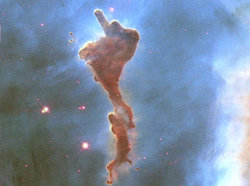Molecular cloud
|
|
A Molecular cloud is a type of interstellar clouds whose density and size permits the formation of molecular hydrogen, H2. However, this molecule is difficult to detect, and the molecule most used to trace the H2 is CO (carbon monoxide). The ratio between CO luminosity and H2 mass is roughly constant, although there are reasons to doubt this assumption in observations of some other galaxies.

In the Milky Way, molecular clouds account for roughly one-half of the total gas mass within the Sun's orbit, making them a significant component of the Galactic disk. Catalogues of clouds exhibit that most of the molecular mass is concentrated in the most massive object, which comprise several million solar masses. They inhabit a plane of roughly 50–75 parsec scale height, much thinner than the other gaseous components like atomic and ionized hydrogen. They are thought to lie primarily within the spiral arms, but the degree to which this is true is uncertain in our galaxy because of the difficulty of estimating distances and in other galaxies because high-resolution observations (which may show clearly delineated spiral arms) are not sensitive to a uniform background of CO emission.
To our knowledge, the creation of newborn stars in the current Universe occurs exclusively within molecular clouds. This is a natural consequence of their low temperatures and high densities, and of the observed evidence that the large, star-forming clouds are confined to a large degree by their own gravity (like stars, planets, and galaxies) rather than external pressure (like clouds in the sky). The evidence comes from the fact that the "turbulent" velocities inferred from CO linewidth scale in the same manner as the orbital velocity (a virial relation).
The physics of molecular clouds are poorly understood and much debated. Their internal motions are governed by turbulence in a cold, magnetized gas, for which the turbulent motions are highly supersonic but comparable to the speeds of magnetic disturbances. This state is thought to lose energy rapidly, requiring either an overall collapse or a steady reinjection of energy. At the same time, the clouds are known to be disrupted by some process—most likely the effects of massive stars—before a significant fraction of their mass has become stars.de:Globule fr:Nuage moléculaire it:Nube molecolare gigante pl:Chmura molekularna
